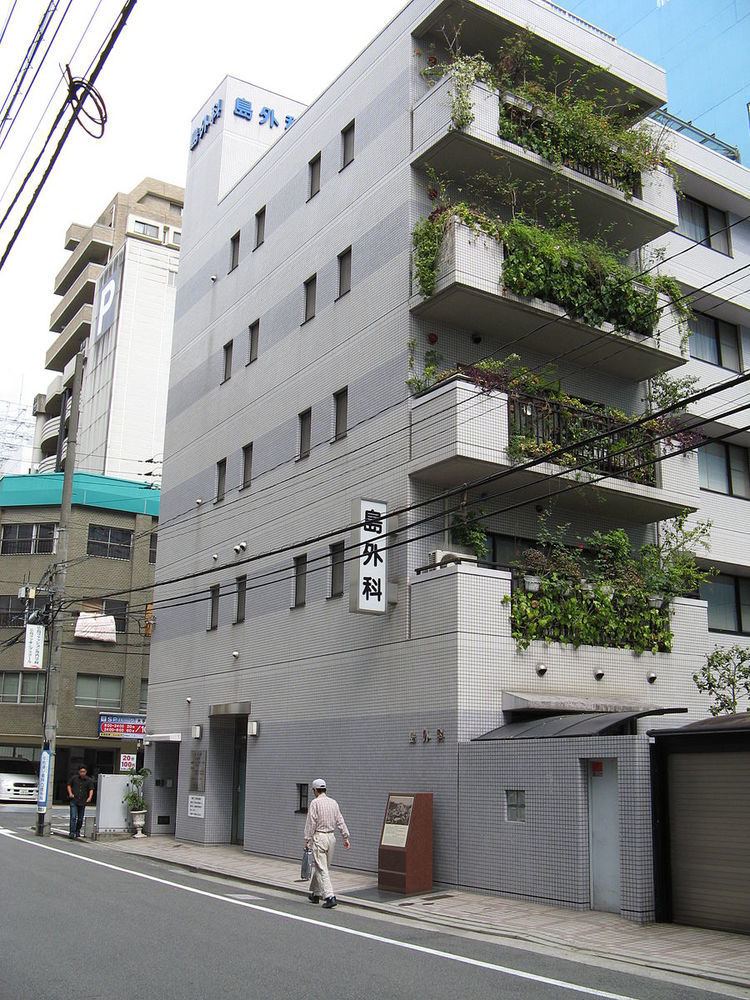Hospital type Private Founded 1933 | Emergency department No Phone +81 82-249-6161 | |
 | ||
Address Japan, 〒730-0051 Hiroshima Prefecture, Hiroshima, 中区大手町1−5−25 Hours Closed now Saturday9AM–12:30PMSundayClosedMonday9AM–12:30PM, 3:30–6PMTuesday9AM–12:30PM, 3:30–6PMWednesday9AM–12:30PM, 3:30–6PMThursday9AM–12:30PMFriday9AM–12:30PM, 3:30–6PMSuggest an edit Similar Aioi Bridge, Children's Peace Monument, Hiroshima Peace Memorial, Hiroshima National Peace M, Hiroshima Peace Memorial | ||
hypocenter shima hospital in hiroshima
Shima Hospital (島病院, Shima byōin) was a Japanese hospital destroyed by the atomic bombing of Hiroshima, Japan, on August 6, 1945. Shima Hospital is considered to be ground zero for the atomic bombing of Hiroshima.
Contents
In 1948, the hospital was rebuilt from the ground up by Dr. Kaoru Shima. The reconstructed Shima Surgery is still in operation to the present day under the name Shima geka naika(島外科内科). Specialities of the present Shima geka naika are surgery, orthopaedics, internal medicine, and endoscopic treatment of the digestive organs. Adjacent to the Shima geka naika is a monument marking the hypocenter, or ground zero, of the atomic bomb explosion over Hiroshima, which is located about a five-minute walk away from the city's Atomic Bomb Dome or "A-Dome."
Beginnings
Dr. Shima's family had overseen an established medicine practice in Hiroshima since the late 18th century. Proof of this can be found in a map of Nakanomura dated approximately 1780, in which the residence of the Shima family, birthplace of "Shima Hospital" founder Dr. Kaoru Shima, is noted as a clinic.
Dr. Kaoru Shima (1897–1977) graduated from the Osaka medical school, the present Osaka University medical department, which originated in the "Tekijuku" school. After graduating, he travelled throughout Europe and the United States to further his medical studies.
Following his quest to learn the latest developments in medicine and surgery and with his reputation as an excellent surgeon, he became lecturer of medicine at the Osaka Empire University (now the Osaka University), considered a high honor at the time, as the title of "honour lecturer" did not exist and Dr. Shima had a full-time occupation in Hiroshima. On August 31, 1933, Shima Hospital was founded. The Mayo Clinic served as Dr. Shima's model of choice. Shima Hospital was a two-storey building of brick construction with reinforced walls and a modern design. Kaoru Shima applied the rational hospital management concepts he learned in the U.S., resulting in Shima Hospital's popularity as an inexpensive clinic with a high standard of treatment. Shima Hospital, following the Mayo Clinic model, is an exception to the usual profile of hospitals found in pre-war Japan that were based on German models and medical procedures.
Atomic bombing
On August 6, 1945, Shima Hospital was completely destroyed by the atomic bombing of Hiroshima; the atomic bomb detonated right above the building and the blast was directed downwards. Because the epicenter of the atomic bombing of Hiroshima is over the hospital, the hypocenter, or ground zero, is the hospital itself. All the medical staff and the inpatients who were in Shima Hospital, about 80, died instantly. At the time of the detonation, Kaoru Shima was away from Hiroshima city, as he had gone to assist a colleague with a difficult operation at a hospital in a nearby town. Thus he and his attending nurse were the only survivors of the Shima Hospital staff.
Dr. Kaoru Shima returned to Hiroshima on the night of August 6 and began treatment of the injured people. On the afternoon of August 7, Shima found an operation tool he'd purchased in the U.S. at the site of the destroyed hospital, the only remaining trace of the structure. Kaoru Shima and the nurse found a large quantity of bleached bones at the bottom of the debris, as the corpses had immediately become skeletonized by the blast.
Shima learned American medical care and practised American medical care at his hospital. Therefore, the war with the U.S. was a considerable shock for him. Shima disagreed with the Pacific War, and risked being killed by special political police, .
Shima's son had evacuated on August 6, 1945, and had also survived. He would also become a doctor, and later became director of the hospital in its second incarnation.
Rebuilding
Shima rebuilt the hospital at the same site during the difficult post-war period. The new hospital opened for medical treatment in 1948. Shima was quoted as saying, "My new hospital is dedicated to peace and caring for the underprivileged and poverty stricken." The 1990s saw the clinic change into a clinic of surgery and decrease the number of beds. The name was changed to "Shima geka."
On August 1, 2009, the clinic's name was changed to "Shima geka naika." Shima's son retired and become the honorary director. The current director of the clinic, a grandson of Kaoru Shima, is the third generation of this family to work in the hospital. The specialities of the present Shima geka naika are surgery, orthopaedics, internal medicine, and endoscopic treatment of the stomach and intestines. The director of today's hospital focuses on community care and thus maintains the ideals and spirit of his grandfather. The present Shima geka naika performs smoking cessation treatment, preventive injection, general medical examinations, cancer screening, and stress consultations. Shima geka naika cooperates with the Hiroshima Red Cross Hospital & Atomic-bomb Survivors Hospital.
